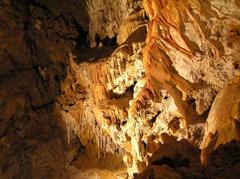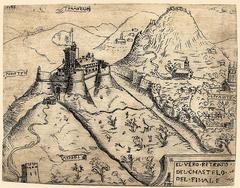Mausoleo Enrico Caviglia: Complete Guide to Visiting Hours, Tickets, History, and Travel in Finale Ligure, Italy
Date: 14/06/2025
Introduction
Rising above the turquoise waters and rugged coastline of Capo San Donato, the Mausoleo Enrico Caviglia is a landmark that seamlessly weaves together Finale Ligure’s medieval military heritage and Italy’s twentieth-century history. Once a coastal watchtower built to defend against Saracen raids, it was transformed in the mid-1900s into a national monument honoring General Enrico Caviglia (1862–1945)—a local son and one of Italy’s most celebrated military leaders.
This in-depth guide explores the mausoleum’s layered history, architectural significance, and cultural role. You’ll find essential details on visiting hours, ticketing (admission is generally free), accessibility, transportation, guided tours, and recommended nearby attractions. Practical travel advice and photographic highlights round out everything you need for a memorable visit.
For the latest updates, always consult official Finale Ligure tourism resources and local cultural organizations (Comune di Finale Ligure, Museo Diffuso del Finale, Live the World).
Table of Contents
- Historical Overview
- Architectural Features
- Visitor Information
- Cultural and Historical Significance
- Photography and Travel Tips
- FAQ
- Conclusion
- Resources and Links
Historical Overview
Capo San Donato and Its Defensive Heritage
The mausoleum’s tower originated as part of a chain of coastal fortifications constructed between the 9th and 10th centuries. Its vantage point atop Capo San Donato offered protection against Saracen incursions, with panoramic views essential for early warning. As piracy waned, the watchtower’s military role declined, but its strategic position endured, eventually lending itself to a new purpose as a monument (Comune di Finale Ligure).
General Enrico Caviglia’s Life and Legacy
Born in Finalmarina (now part of Finale Ligure), Enrico Caviglia excelled at the Accademia Militare di Torino and advanced through major campaigns—Adwa, the Italo-Turkish War, and World War I. He played a pivotal role in the 1918 Battle of Vittorio Veneto, which helped secure Italy’s victory. Later, he served as Minister of War and commanded Rome’s defenses during WWII. Caviglia died in 1945 and, in 1952, was interred in the transformed Capo San Donato tower (it.wikipedia.org - Enrico Caviglia).
Creation and Symbolism of the Mausoleum
The mausoleum was inaugurated in 1952, attended by national dignitaries, and stands as a site of solemn remembrance. Its sea-facing isolation evokes both vigilance and reflection, honoring Caviglia’s legacy and Italy’s history (Museo Diffuso del Finale).
Architectural Features
Origins and Evolution of the Tower
Built in the early Middle Ages, the original tower features thick stone walls and a commanding cylindrical form typical of Ligurian defenses. When adapted as a mausoleum, its robust exterior was preserved, while the interior was reconfigured for commemorative purposes (Comune di Finale Ligure). Distinctive elements include slit windows and a parapet, reminders of its defensive role.
Interior and Memorial Elements
Inside, the mausoleum’s atmosphere inspires reverence. The burial chamber is marked by a dignified sarcophagus or plaque, surrounded by military insignia and commemorative inscriptions. Artifacts related to Caviglia’s career may be displayed. Restoration has balanced preservation of the original masonry with accessibility (Museo Diffuso del Finale).
Integration with the Landscape
The mausoleum sits harmoniously within Mediterranean scrub and pines on the Le Manie plateau, offering spectacular views of the Ligurian Sea and coastline. This setting underscores both its historical defensive function and current commemorative role (Live the World).
Visitor Information
Hours, Tickets, and Admission
- Opening Hours: The mausoleum is typically open to visitors during daylight hours, generally from 9:00 AM to sunset. Note that regular daily access may be limited outside special events or by appointment. Always check for updated hours with the Finale Ligure tourism office or official site.
- Tickets: Entry is free, though guided tours or special openings might require a modest fee.
Getting There
- By Foot or Car: From Finale Ligure, scenic walking trails or a short drive (parking is limited at trailheads) lead to Capo San Donato.
- By Public Transit: Regular buses run along Via Aurelia, stopping near marked trailheads. From there, it’s a moderately challenging walk to the mausoleum (Moovit).
- By Train: Finale Ligure Marina station is about a 20-minute walk away.
Accessibility
The approach includes uneven terrain and stairs, making the site less suitable for visitors with limited mobility. Sturdy footwear is recommended.
Guided Tours and Events
Guided tours can be arranged via local associations or during commemorative events. Tours provide in-depth insights into the site’s history and significance (Società Guide Alpine Finale). Major ceremonies occur on anniversaries, such as the Battle of Vittorio Veneto or Caviglia’s birthday.
Nearby Attractions
- Finale Ligure Old Town (Finalborgo): Explore medieval streets and artisan shops.
- Varigotti Beach: Enjoy one of Liguria’s most beautiful beaches.
- Le Manie Plateau: Hiking and mountain biking trails with panoramic views.
- Forte San Giovanni and Fortezza di Castelfranco: Other significant military sites.
- Museo Archeologico in Finalborgo: Archaeology and regional history.
Cultural and Historical Significance
The mausoleum is a powerful symbol of national memory, connecting Finale Ligure’s medieval defensive legacy with twentieth-century military achievements. It serves as both a place of education—often included in local historical tours—and a tranquil site for reflection and remembrance (Comune di Finale Ligure).
Photography and Travel Tips
- Best Times: Sunrise or sunset for dramatic lighting and fewer visitors.
- Gear: Camera, comfortable shoes, water, and sun protection.
- Etiquette: Respect the solemn atmosphere; avoid disruptive behavior.
- Combine Activities: Pair your visit with hikes or cultural explorations in Finale Ligure.
Frequently Asked Questions (FAQ)
Q: What are the mausoleum’s visiting hours?
A: Usually open during daylight hours; always confirm with local tourism resources.
Q: Is there an entrance fee?
A: No, admission is free. Guided tours may have a small fee.
Q: Are guided tours available?
A: Yes, book through local associations or during commemorative events.
Q: Is the site accessible for people with mobility impairments?
A: Due to stairs and uneven paths, accessibility is limited.
Q: How do I reach the mausoleum from the train station?
A: Walk approximately 20 minutes from Finale Ligure Marina station or take a bus to a nearby stop.
Q: Can I combine my visit with other attractions?
A: Absolutely—Finale Ligure offers a wealth of historic, natural, and cultural sites nearby.
Conclusion
The Mausoleo Enrico Caviglia is a profound testament to Liguria’s layered history—anchoring Finale Ligure’s medieval defensive spirit and Italy’s twentieth-century military memory in a breathtaking coastal setting. Free to visit and often included in guided tours, the site offers both a deep educational experience and moments of peaceful reflection. With careful planning and attention to up-to-date hours and local events, you can fully appreciate one of the region’s most iconic monuments.
For further details, download the Audiala app, consult official tourism platforms, and explore related guides to make the most of your journey.
Resources and Official Links
- Comune di Finale Ligure – Official Tourism Portal
- Museo Diffuso del Finale – Torre di San Donato
- Visit Finale Ligure – Monuments
- Live the World – Finale Ligure
- Checkin Blog: What to See in Finale Ligure
- Wikipedia: Enrico Caviglia
- Moovit: Public Transit to Mausoleo Enrico Caviglia
- Società Guide Alpine Finale

